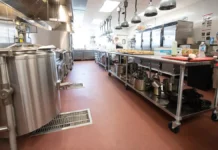
Farm-to-table restaurants have become increasingly popular in recent years, with consumers seeking out fresh, locally-sourced ingredients and a closer connection to the food they eat. As a chef considering opening a farm-to-table restaurant, there are several key factors to consider in order to create a successful and sustainable business. Let’s explore some of the important steps for how to start a farm-to-table restaurant and where to get all the latest chef news.
Finding the Right Suppliers
The foundation of any good farm-to-table restaurant is sourcing high-quality, fresh ingredients from local suppliers. Chefs should do their research and build relationships with local farmers, ranchers, and fishermen to ensure a consistent supply of the freshest, seasonal ingredients. It’s important to work with suppliers who share your values and commitment to sustainability and ethical farming practices.
Checking Out Your Competition
Before opening a farm-to-table restaurant, it’s important to research the competition in your area. Identify other restaurants that are using local, seasonal ingredients and analyze their menus, pricing, and marketing strategies. This will give you an idea of what works and what doesn’t, and help you differentiate your restaurant.
Hiring the Perfect Staff
A farm-to-table restaurant requires a dedicated and passionate staff who share your vision and commitment to sustainability. Chefs should look for employees who are knowledgeable about local ingredients and can help educate customers about the benefits of eating locally-sourced food. Front-of-house staff should also be trained to provide exceptional service and communicate the values of the restaurant.
Writing Up Your Business Plan
A well-written business plan is essential for any restaurant, and particularly important for a farm-to-table establishment. The plan should outline your mission, target market, financial projections, and marketing strategy. It should also include a detailed analysis of the competition and an overview of your sourcing and supply chain.
Start by Growing Some of Your Own Produce
Many farm-to-table restaurants have their own on-site gardens or work with local farmers to grow their own produce. This not only ensures a consistent supply of fresh ingredients, but also allows chefs to experiment with new flavors and create unique dishes. Consider what you can realistically grow on-site and what crops are better sourced from local farms.
Create a Menu You and Your Customers Will Love
Your menu should reflect your commitment to locally-sourced, seasonal ingredients and showcase regional flavors when possible. It’s important to balance popular dishes with more adventurous options that highlight lesser-known ingredients. Be sure to test your dishes extensively and get feedback from customers before finalizing your menu.
Put Together a Clear Marketing Plan
Marketing a farm-to-table restaurant requires a different approach than traditional restaurants. Use social media and local publications to promote your commitment to sustainability and the quality of your ingredients. Host events and tastings to build relationships with customers and showcase your menu. Partner with local food bloggers and influencers to get the word out about your restaurant.
Design the Restaurant Floor Plan
The floor plan design of your restaurant should reflect your commitment to sustainability and the natural environment. Use eco-friendly materials and design elements that incorporate natural light and greenery. Consider an open kitchen to showcase your chefs and emphasize the transparency of your sourcing and cooking methods.
Choose the Ultimate Location
Location is key when opening any restaurant, and a farm-to-table establishment is no exception. Look for a space that is easily accessible, with ample parking and foot traffic. Consider the surrounding community and its demographics, and look for a space that fits your vision and aesthetic.
Find Suppliers and Information to Help With Your Farm-to-Table Restaurant at Total Food Service
Total Food Service is a valuable resource and leading foodservice and restaurant industry publication for chefs and restaurateurs looking to start a farm-to-table restaurant. We provide access to a wide range of local suppliers, as well as industry news, trends, and resources. Subscribe to Total Food Service to stay up-to-date on the latest developments in the farm-to-table movement and connect with the best suppliers, distributors, and industry experts for your farm-to-table restaurant needs.

























